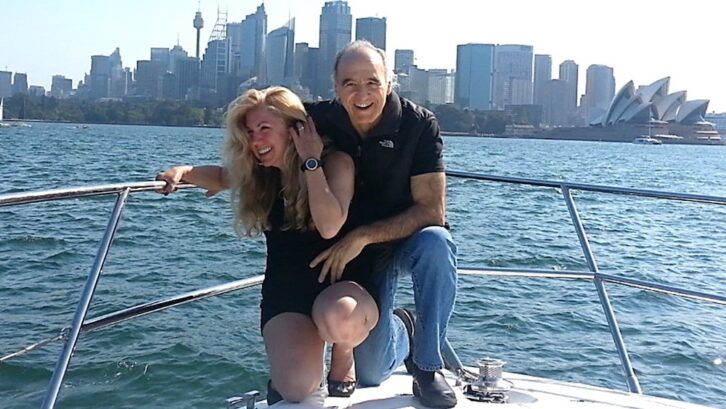Peter D’Antonio Talks Studio Design, 40 Years of RPG and a Lifetime of Science and Sound.
BY TOM KENNY ⋅

Don’t miss Part 1 in our extensive interview with Dr. Peter D’Antonio, founder of RPG Diffusor Systems.
You still didn’t have a product, though, correct?
By the time of Real World, we did, but at the start, they were all custom to a project. The first units that I built were four feet wide and about two feet deep, and included 43 wells with a one- inch width. I called them the 4311 and started building them in my home.
For these diffusers, all you need is a rigid surface, so I wound up using plywood because it had to have multiple layers and it worked. The biggest problem was I had to divide the wells, and they had varying depth; they were like waveguides, but you have to prevent the wells from interfering with one another. You have to put these dividers that went from the face of the unit to the back of the unit and separated the wells—at each well, the sound had a different time. That’s really what that constructive interference is, what creates the diffusion. In theory, the dividers should have been infinitely thin, so I decided to use metal. I found a local vendor of sheet aluminum, and my oven handled the annealing. I was manufacturing in my carport, which I eventually converted to a garage.
Reflection phase grating was different. It wasn’t the first form of diffusion—you had columns, balustrades, coffered ceilings, all kinds of surfaces that scattered sounds. What made reflection phase grating unique was that it was not dependent on the angle of incidence. It was invariant to the angle of incidence and invariant to the frequency, to a certain extent. I did a lot of research, and I had to modify the design of the diffusers over the years because the original RPG was essentially like a midrange speaker. I eventually developed a high-frequency diffuser, a mid-frequency diffuser and a low-end diffuser, but they all incorporated the RPG form. We were awarded a patent in 1987 for the QRD 734, which became the first commercially developed and available sound diffusor.
And then everything flowed smoothly and here we are 40 years later!
[Laughs] Well, we did have a few products now, but I had been doing a lot of theoretical predictions, and as RPG continued to grow, I really felt the urgency to verify all of that experimentally, for a variety of reasons. First, scientists like to verify things, but also I wanted to eventually develop a diffusion coefficient that could be used alongside the absorption coefficient. I needed to develop an experimental method to measure and document their performance so they could be specified by acousticians and added to the acoustical palette.
I began a systematic program of experimental measurements, using the TEF analyzer, beginning in large sports facilities, then my son’s high school gymnasium. When we wore out our welcome, we developed a new scale-model measurement system called a Goniometer, which was another example of how my experience in crystallography led to a development in acoustics. This research eventually led to the current ISO 17497-2 diffusion coefficient measurement standard published in 2012.

Right after I developed my capability to measure a polar response, I got a call from the editor of the Journal of the Acoustical Society of America asking me to referee a paper by a guy named Trevor Cox, a recent graduate on the topic, I read it, and I thought, “Oh my God. This is like an incredible freakin’ paper. Unbelievably creative. What Trevor did was he wrote a boundary element code. He was using a different theory than my simulations, noting that because the wavelength of a sound is a million times bigger than the wavelength of electromagnetic radiation, which is what I was using—x-rays as I did in crystallography. You have to use a different theory called wave theory, basically solving what is called the wave equation.
Without diving into the science, this relationship with Trevor eventually led to the co-authorship of three reference books on acoustics, development of software that would eventually lead to a virtual goniometer and the formation of NIRO and REDI Acoustics, and, of course, the co-efficient, which now allows us to predict the performance of a future space as accurately as we could measure it.
We haven’t even talked about Real World, Hit Factory, Blackbird Studio C, Jungle City, the just-opened Rue Boyer in Paris, or any of the hundreds of projects you’ve contributed to.
I’ve been very fortunate in my life, working with such talented and creative designers. Don Davis, Bob Todrank, Chips Davis, Steve Blake, Neil Grant, John Storyk, Russ Berger, Doug Jones, Steve Langstaff, Neil Muncy, Lennert Nilsson, Bob Richards, Bob Skye, Martin Pilchner, Chris Pelonis, and most recently, Wes Lachot—I’ve learned from all of them, and I consider them all friends to this day.
You just turned 81, and you’re celebrating 40 years of RPG. You got a late start! But it doesn’t seem like you’re slowing down all that much.
Well, I sold RPG Diffusor Systems in 2016, and then in 2017, I launched a new entity known as RPG Acoustical Systems to manufacture the products designed prior by RPG Diffusor Systems and begin research and development into new areas. We added the Acoustical Research Center with a 285 cubic-meter rev room, a new Goniometer and a seven-ton, 25-foot-long long impedance tube. We invite any and all to join the ARC Associates Alliance and share the facility.
But if I were to look back, I’m most proud of the fact that we now know how to design, predict, optimize, measure, characterize and standardize the performance of scattering surfaces. While there is still much to do, there is a general consensus in the architectural acoustics community that a solid theoretical and experimental foundation has been laid, that diffuser performance can now be quantified and standardized, and that diffusers can now be integrated into contemporary architecture, taking their rightful place along with absorbers and reflectors in the acoustical palette. The future holds exciting possibilities, and we’re looking forward to the next 40 years!









